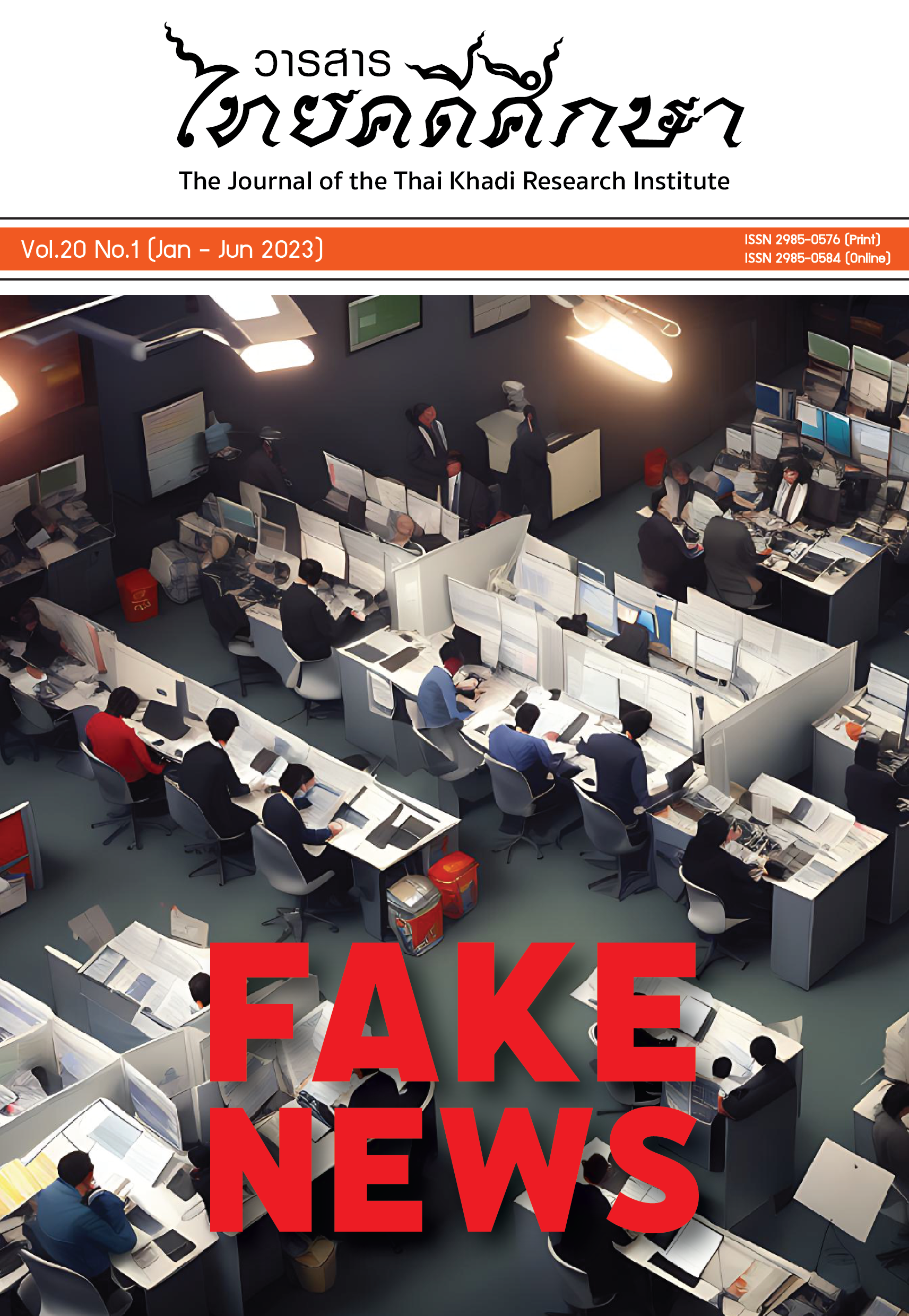แช่ม บุนนาค กับการสร้างต้นตำนานอุไทย: ประวัติศาสตร์แบบใหม่ ต้นกำเนิดชนชาติไทย และการย้ายถิ่นฐานของชนชาติไทย (ค.ศ. 1889 - 1890)
Main Article Content
บทคัดย่อ
บทความนี้ศึกษาความสัมพันธ์ระหว่างการสร้างประวัติศาสตร์และบริบททางการเมืองระหว่างประเทศในปลายศตวรรษที่ 19 อันเป็นช่วงเวลาที่เกิดความขัดแย้งเรื่องเขตแดนระหว่างอังกฤษและสยามในบริเวณสาละวินและรัฐฉาน ในบทความนี้ศึกษาผ่านงานเขียนเรื่อง ต้นตำนานอุไทย ซึ่งถูกเรียบเรียงโดยแช่ม บุนนาค (ค.ศ. 1864 - 1907) ท่านเป็นข้าราชการชาวสยามที่ไปทำงานที่ศาลต่างประเทศที่เชียงใหม่ใน ค.ศ. 1883 และท่านยังเป็นหัวหน้าคณะสำรวจเขตแดนในบริเวณสาละวินและรัฐฉานตั้งแต่ ค.ศ. 1889 - 1890
งานที่ศึกษาเกี่ยวกับงานเขียนของแช่มเน้นไปที่การศึกษา พงศาวดารโยนก (ค.ศ. 1907) เป็นหลัก แต่งานที่ศึกษา ต้นตำนานอุไทย โดยตรงนั้นไม่ปรากฏแต่อย่างใด ดังนั้น ในบทความชิ้นนี้จะศึกษางานเขียนของแช่ม บุนนาค เรื่อง ต้นตำนานอุไทย โดยศึกษาประเด็นการสร้างประวัติศาสตร์ของแช่มว่าเป็นอย่างไร และลักษณะเฉพาะของงานชิ้นนี้เป็นอย่างไร การศึกษาครั้งนี้พบว่างานเขียนของแช่มชิ้นนี้ถูกสร้างขึ้นมาภายใต้บริบทความขัดแย้งเรื่องเขตแดนระหว่างอังกฤษและสยามใน ค.ศ. 1889 (the Anglo - Siamese territorial conflict) ทำให้แช่มสร้างงานเขียนต้นตำนานอุไทยในลักษณะของประวัติศาสตร์แบบใหม่ที่มีประเด็นเรื่องกำเนิดชนชาติไทยและการย้ายถิ่นฐานของชนชาติไทยจากอินเดียกลางและจีน
Downloads
Article Details

อนุญาตภายใต้เงื่อนไข Creative Commons Attribution-NonCommercial-NoDerivatives 4.0 International License.
ผู้เขียนจะต้องลงนามในแบบฟอร์มรับรองบทความ เพื่อให้คำยืนยันความรับผิดชอบว่า บทความของผู้เขียนนั้นไม่เคยตีพิมพ์ที่ใดมาก่อน พร้อมรับทราบว่า กระบวนการส่งบทความเข้าพิจารณาและตีพิมพ์ในวารสารไทยคดีศึกษานั้น จะไม่มีการเรียกเก็บค่าใช้จ่ายในการดำเนินการ ยกเว้น ในกรณีที่ผู้เขียนขอยกเลิกการตีพิมพ์บทความในวารสารไทยคดีศึกษาไม่ว่าด้วยสาเหตุใด และหลังจากบทความนั้นเข้าสู่กระบวนการพิจารณาของผู้ทรงคุณวุฒิไปแล้ว ผู้เขียนจะต้องรับผิดชอบต่อค่าใช้จ่ายที่เกิดขึ้นในกระบวนการประเมินเป็นจำนวนเงิน 3,000 บาท (สามพันบาทถ้วน)
เอกสารอ้างอิง
Foreign Office [F.O]. Further Correspondence Respecting the Affairs of Burmah, 422/17. (1886). Inclosure 1 in No. 93: from Mr Satow to the Chief Commissioner of Burmah, 9 November. n.p.
Foreign Office [F.O]. Further Correspondence Respecting the Affairs of Burmah, 422/17. (1885). Part II Further Correspondence Respecting the Affairs of Burmah, January to June 1886, In closure 5 in No. 81, from Vice - Consul Gould to Mr Symes, written in Chieng Mai, 22 December. n.p.
Foreign Office [F.O]. Further Correspondence Respecting the Affairs of Burmah, 422/18. (1887). Part II Further Correspondence on the Affairs of Burmah, 1887, In Enclosure No. 15. The Governor - General of India in Council to Viscount Cross, Fort William, 25 January. n.p.
Foreign Office [F.O]. Further Correspondence Respecting the Affairs of Burmah, 422/2. (1889). Enclosure No. 47. The Marquis de Montri [Praya Montri Surywangse, a high - ranking Siamese administrator] to the Marquis of Salisbury, written by the Siamese Legation, 23, Ashburn Place, London, 7 April. n.p.
Iijima, A. (1994). Phongsawadan yonok: the modern Siamese historiography. Paper Presented at 13th IAHA Conference in September 5 - 9 (1 - 19). Tokyo: Sophia University.
Keys, C. (1995). Who Are the Tai ? Reflections on the Invention of Local, Ethnic and National Identities. In Lola R, and George A. De Vos. (eds). (3rd ed). Ethnic Identiry: Creation Conflict, and Accommoda tion (136 - 160). Walnat Creek, CA: Alta Mira Press.
Mead, K. (2004). The Rise and Decline of Thai Absolutism. London: Routledge Curzon.
National Archive of Thailand, R.5 กระทรวงการต่างประเทศ [The Ministry of Foreign Affair] 40/2. (1889). เขตแดนอังกฤษ [The British Boundary]. n.p.
National Archive of Thailand, R.5 กระทรวงราชเลขาธิการ [The Department of Secretary] 99/38. (1890). ต้นตำนานอุไทย [The Origin of the Uthai Chronicle]. n.p.
Ongsakul, S. (2005). History of Lan Na. In Dolina W. Millar, S (ed.), Tanratanakul, C (T.). Chiang Mai: Silkworm Books.
Osatharom, W. (2005). เรื่องโรงเรียนสวนอนันทอุธยาน: บทวิเคราะห์วัฒนธรรมความคิดทางการศึกษา [Brief history of a government school for English in Bangkok prepared by Dr. S. G. MacFarland]. Ratthasat San, (26)3, 240 - 291.
Phayre, Arthur P. (1883). History of Burma: Including Burma Proper, Pegu, Taungu, Tenassaerim, and Arakan from Earliest Time to the End of the First War with British India. London: Trübner & Co., Ludgate Hill.
Prachakadikit, K. (1885). ว่าด้วยประเภทคนป่าฤาข่าฝ่ายเหนือ [The history of people in the North]. Wachirayan Wisat, (1)9, 164 - 166.
Rachanuphab, D. (1914). ประชุมพงศาวดาร ฉบับพระราชหัตถเลขา เล่ม 1 [The Royal historical writing, Volume 1]. n.p.
Saiphan, P. (2018). การศึกษาคนไทในรัฐอัสสัม อินเดีย: “จากแนวคิดรากเหง้าดั้งเดิม” สู่ “การกำเนิดทางชาติพันธุ์” [The study of the Tai peoples in Assam State, India: from “Primordialism” to “Racist nationalism” and “Situational ethnicity”]. Journal of Anthropology, 1(1), 87 - 88.
Suntrawanit, C. (1972). วิวัฒนาการการเขียนประวัติศาสตร์ไทย จากเจ้าพระยาทิพากรวงศ์ ถึง สมเด็จพระเจ้าบรมวงศ์เธอ กรมพระยาดำรงราชานุภาพ ศึกษาเปรียบเทียบพระราชพงศาวดาร กรุงรัตนโกสินทร์ รัชกาลที่ 2 [The development of Thai historical writing from Thiphakorawong to Damrong Rachanuphap: the comparative with the history of Thai during the second reign]. Bangkok: Krom Sinlapakon.
Thanaratanabodi, C. ( 1931). พงศาวดารเหนือ [The North Chronicle]. The cremation book of Phraya Thanarattanabodi. Sophon Phiphat thanakon.
Wacharapradit, R. (2006). พงศาวดารโยนก งานนิพนธ์ท้องเรื่องประวัติศาสตร์ชาติไทยชิ้นแรก [The Yonok Chronicle: the first Thai historical writing]. In Buhra, P (ed.), รวมบทความทางวิชาการ [Collected Academic Artices] (200 - 220). Phitsanulok: Suksawichakan prawattisat khana sang khommasat mahawitthayalai Naresuan.
Wichitmatra, Khun. (1928). หลักไทย [Lak Thai]. Phranakorn: Rong Phim Thai.
Wichitwathakan, Luang. (1930). ประวัติศาสตร์สากล ฉบับ 6 [Universal History, Volume 6]. Bangkok: Saengdao.
สมาคมสืบสานบุรานในประเทศสยาม พระราชดำรัสของสมเด็จพระจุลจอมเกล้าเจ้าอยู่หัวและพระบรมราชโองการดำรัสสั่งให้สำรวจลำดับเก้า [The Antiquarian Society of Siam Speech of King Chulalongkorn]. (2008). Journal of the historical Society, 30, 5 - 27.
หนังสืองานศพพระยาประชากิจกรจักร [The cremation book of Phraya Prachakitkonchak]. (1913). Bangkok: Wat Pra Yurawongsawat Krung thep Fang Tawantok.


